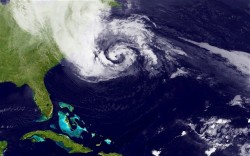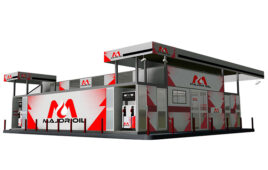Gas demand expected to dip as streets remain flooded and  Northeastern residents—in some areas—are encouraged to remain in doors.
Northeastern residents—in some areas—are encouraged to remain in doors.
More than 8.1 million U.S. homes and businesses were without power on Tuesday after Hurricane Sandy wreaked havoc, tearing down power lines, flooding electrical networks and causing an explosion at a Consolidated Edison substation on Manhattan’s East River, Reuters reported.
“Gasoline demand will suffer dramatically due to Hurricane Sandy, with motorists in affected areas told—in some cases ordered—to stay off the roads. That should sharply pressure wholesale gasoline costs once the storm passes, with U.S. gasoline demand already weak in 2012, trailing the 2011 pace by a sharp 3.8%.,” noted Brian Milne, Refined Fuels Editor for Telvent DTN.
AAA reported on Monday that due to Hurricane Sandy, two of six Northeast refineries, totaling more than 300,000 barrels per day (bpd) of production, temporary closed, as did many oil terminals in the northeast. The four remaining refineries are expected to operate at reduced rates for the duration of the storm. The total capacity of these six refineries is an estimated 1.17-million bpd.
AAA noted that unlike Hurricane Isaac, Hurricane Sandy is impacting an area that is a major consumer of gasoline rather than a major producer. Lower regional production along with storm concerns pushed gas prices higher on Monday. While gas demand at this time of year is usually near 8.5-million bpd, AAA predicts demand will be at least one-million bpd lower for the next several days, which could push pump prices lower. “Assuming a smooth restart to production and distribution following Hurricane Sandy, AAA expects that gas prices across the country will continue to drop leading up to Election Day and will move even lower approaching the end of the year,” AAA reported.
Northeasterners Recovering
About a quarter of New York City’s homes and businesses remain without power some 15 hours after Hurricane Sandy arrived, bringing a nearly 14-foot tidal surge that flooded empty subway and highway tunnels, Reuters noted.
According to Con Edison, parts of New York City are expected to remain without power for a more than a week, and Mayor Michael Bloomberg confirmed the subway would likely be out of commission for 4-5 days.
New York isn’t alone. The storm’s effects are being felt across the entire coastline of the Mid-Atlantic region, up through New England and into inland areas as far as the Great Lakes area. Power outages remain in every state from North Carolina to the Canadian border and as far inland as Ohio and Indiana. New Jersey was the hardest hit state with 62% of customers suffering blackouts, Reuters reported.
Finch Weighs In On Insurance Claims, Losses
In Sandy’s wake, EQECAT Inc.’s initial insured loss estimate is between $5 billion-$10 billion, with economic damages of approximately $10 billion-$20 billion. At the low end, losses from Sandy would roughly equal losses generated by Hurricane Irene, which struck the East Coast in August 2011. However, due to the widespread nature of the storm, it will take some time for catastrophe modeling firms and local loss adjusters to accurately estimate insured losses.
Fitch Ratings expects that flooding from excessive rainfall and high storm surge will be a substantial component of damages from Sandy, in addition to damage from strong winds. Many commercial policies cover both wind and flood losses, as do crop insurance policies.
There is the potential for significant business interruption (BI) and contingent business interruption (CBI) losses related to the flooding as the affected areas work to restore power and resume operations following the storm. The massive storm is impacting a wide variety of businesses in densely populated areas, including retail, corporate offices, transportation, manufacturing and energy plants, according to a Fitch report.
In order to incur a BI or CBI loss, an insured business must suffer an actual loss of income from the suspension of operations. In the case of BI, the interruption must be due to physical loss or damage to its own property as a result of a covered cause of loss. A BI claim can also be triggered if the work location is not accessible due to a “civil authority” order telling people to stay out of an area.
CBI provides an additional protection that covers loss of income when the insured’s operations are disrupted by a supplier and covers the same perils as the main policy of the insured. However, the majority of companies do not purchase CBI policies.
Coverage typically begins following a waiting period, most often 72 hours, and continues for the length of time it takes to repair, rebuild, or replace the damaged or destroyed property with reasonable speed and similar quality. Thus, the ultimate insured losses from BI and CBI will be partly predicated on the speed with which businesses resume operations. It is also important to note that the vast majority of BI and CBI coverage purchased in the U.S. is included as part of the insured’s property policy, and are thus included within the overall property policy’s coverage limits.




